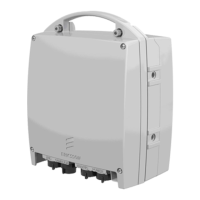MINI-LINK BAS 7-4
Technical Description EN/LZB 111 0542 P2B
7.2.1 VP/VC Connection Plan
The system uses point-to-point Virtual Channel (VC) connections, but
it is ready in all its parts to support Virtual Path (VP) connections.
VP connections are unused just because the available user ports,
Ethernet 10/100BaseT and E1/T1 for CE, are always associated with
VC end-points. When ATM user ports, such as the ATM 25.6 Mbps,
will be introduced, they will be usable for both VC and VP
connections crossing the boundary between the system and the
customer premises network.
Beside the normal usage for traffic transport, VC connections are also
used as internal communication channels among different parts of the
system.
This aspect is entirely invisible to the operator, except these
connections required by the CP reached through an ATM switch or
network. In such cases, the operator is required to set up appropriate
connections through the ATM switch or network, see Chapter 6.
7.2.2 Use of VPI/VCI Values
In order to simplify the service provisioning process, the system
automatically selects the VPI/VCI values used over all its internal
interfaces, while it lets the operator choose the VPI/VCI values where
they have relevance outside of the system boundaries.
As an example, when a connection is established between an Ethernet
user port and an ATM service port, the only VPI/VCI value the
operator is requested to specify is the one used at the ATM service
port.
Given the types of user ports currently supported, the manual selection
of VPI/VCI values by the operator is only necessary at ET, service or
service-user, ports. Such as selection is subject to constraints on the
supported VPI and VCI ranges.

